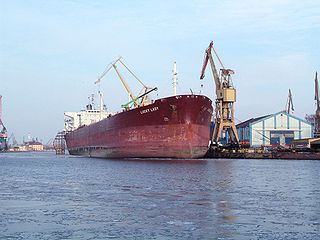Related Research Articles
Negligence is a failure to exercise appropriate care expected to be exercised in similar circumstances.
In common law, battery is a tort falling under the umbrella term 'trespass to the person'. Entailing unlawful contact which is directed and intentional, or reckless and voluntarily bringing about a harmful or offensive contact with a person or to something closely associated with them, such as a bag or purse, without legal consent.

English tort law concerns the compensation for harm to people's rights to health and safety, a clean environment, property, their economic interests, or their reputations. A "tort" is a wrong in civil law, rather than criminal law, that usually requires a payment of money to make up for damage that is caused. Alongside contracts and unjust enrichment, tort law is usually seen as forming one of the three main pillars of the law of obligations.

Overseas Tankship (UK) Ltd v The Miller Steamship Co or Wagon Mound , is a landmark tort case, concerning the test for breach of duty of care in negligence. The Judicial Committee of the Privy Council held that loss will be recoverable where the extent of possible harm is so great that a reasonable man would guard against it.
Causation is the "causal relationship between the defendant's conduct and end result". In other words, causation provides a means of connecting conduct with a resulting effect, typically an injury. In criminal law, it is defined as the actus reus from which the specific injury or other effect arose and is combined with mens rea to comprise the elements of guilt. Causation only applies where a result has been achieved and therefore is immaterial with regard to inchoate offenses.
Causation in English law concerns the legal tests of remoteness, causation and foreseeability in the tort of negligence. It is also relevant for English criminal law and English contract law.
Breaking the chain refers in English law to the idea that causal connections are deemed to finish. Even if the defendant can be shown to have acted negligently, there will be no liability if some new intervening act breaks the chain of causation between that negligence and the loss or damage sustained by the claimant.
In the English law of negligence, the acts of the claimant may give the defendant a defence to liability, whether in whole or part, if those acts unreasonably add to the loss.
In English law, remoteness between a cause of action and the loss or damage sustained as a result is addressed through a set of rules in both tort and contract, which limit the amount of compensatory damages available for a wrong.
In English law, a nervous shock is a psychiatric / mental illness or injury inflicted upon a person by intentional or negligent actions or omissions of another. Often it is a psychiatric disorder triggered by witnessing an accident, for example an injury caused to one's parents or spouse. Although the term "nervous shock" has been described as "inaccurate" and "misleading", it continues to be applied as a useful abbreviation for a complex concept. The possibility of recovering damages for nervous shock, particularly caused by negligence, is strongly limited in English law.

In RePolemis & Furness, Withy & Co Ltd (1921) is an English tort case on causation and remoteness in the law of negligence.

Overseas Tankship (UK) Ltd v Morts Dock and Engineering Co Ltd, commonly known as Wagon Mound , is a landmark tort law case, which imposed a remoteness rule for causation in negligence. The Privy Council held that a party can be held liable only for loss that was reasonably foreseeable. Contributory negligence on the part of the dock owners was also relevant in the decision, and was essential to the outcome, although not central to this case's legal significance.
Economic loss is a term of art which refers to financial loss and damage suffered by a person which is seen only on a balance sheet and not as physical injury to person or property. There is a fundamental distinction between pure economic loss and consequential economic loss, as pure economic loss occurs independent of any physical damage to the person or property of the victim. It has also been suggested that this tort should be called "commercial loss" as injuries to person or property can be regarded as "economic".
The tort of deceit is a type of legal injury that occurs when a person intentionally and knowingly deceives another person into an action that damages them. Specifically, deceit requires that the tortfeasor

Spartan Steel & Alloys Ltd v Martin & Co (Contractors) Ltd [1973] QB 27 is a well-known English Court of Appeal case concerning the recovery of pure economic loss in negligence.

The Law Reform Act 1945 is an Act of Parliament of the United Kingdom, which allows a judge to apportion liability for compensatory damages as he feels to be "just and equitable" between a tortfeasor and an injured person who was partly to blame. Section 1(1) of the Act provides:
"Where any person suffers damage as the result partly of his own fault and partly of the fault of any other person(s), a claim in respect of that damage will not be defeated by reason of the fault of the person suffering the damage, but the damages recoverable in respect thereof shall be reduced to such extent as the court thinks just and equitable having regard to the claimant's share in the responsibility for the damage."
Nuisance in English law is an area of tort law broadly divided into two torts; private nuisance, where the actions of the defendant are "causing a substantial and unreasonable interference with a [claimant]'s land or his/her use or enjoyment of that land", and public nuisance, where the defendant's actions "materially affects the reasonable comfort and convenience of life of a class of His Majesty's subjects"; public nuisance is also a crime. Both torts have been present from the time of Henry III, being affected by a variety of philosophical shifts through the years which saw them become first looser and then far more stringent and less protecting of an individual's rights. Each tort requires the claimant to prove that the defendant's actions caused interference, which was unreasonable, and in some situations the intention of the defendant may also be taken into account. A significant difference is that private nuisance does not allow a claimant to claim for any personal injury suffered, while public nuisance does.
Trespass in English law is an area of tort law broadly divided into three groups: trespass to the person, trespass to goods, and trespass to land.

The eggshell rule is a well-established legal doctrine in common law, used in some tort law systems, with a similar doctrine applicable to criminal law. The rule states that, in a tort case, the unexpected frailty of the injured person is not a valid defense to the seriousness of any injury caused to them.

Chapman v Hearse is a significant case in common law related to duty of care, reasonable foreseeability and novus actus interveniens within the tort of negligence. The case concerned three parties; Chapman who drove negligently, Dr Cherry who assisted him on the side of the road, and Hearse who, in driving negligently, killed Dr Cherry while he was assisting Chapman. In the Supreme Court of South Australia, Hearse was found liable for damages to Dr Cherry's estate under the Wrongs Act 1936. Hearse sought to reclaim damages from Chapman due to his alleged contributory negligence; Chapman was found liable to one quarter of the damages. Chapman appealed the case to the High Court of Australia on August 8, 1961, but it was dismissed as the results of his negligence were deemed reasonably foreseeable. A duty of care was established between Chapman and the deceased and his claim of novus actus interveniens was rejected. Dr Cherry was considered a 'rescuer' and his respective rights remained.
References
- ↑ The eggshell skull rule is also known as the talem qualem rule.
- ↑ [1962] 2 QB 405 (header)
- ↑ Law Report: 2 QB 405 (header)
- ↑ "Cases - tort - negligence - damage". Sixth Form Law. Archived from the original on 10 June 2017.
{{cite web}}: CS1 maint: unfit URL (link) - ↑ [1962] 2 QB 405
- ↑ Hedley Byrne & Co Ltd v Heller & Partners Ltd [1964] AC 465
- ↑ Overseas Tankship (UK) Ltd v The Miller Steamship Co (Wagon Mound No. 2) [1966] UKPC 10 , [1967] AC 617; [1967] 2 All ER 709(25 May 1966), Privy Council (on appeal from NSW).